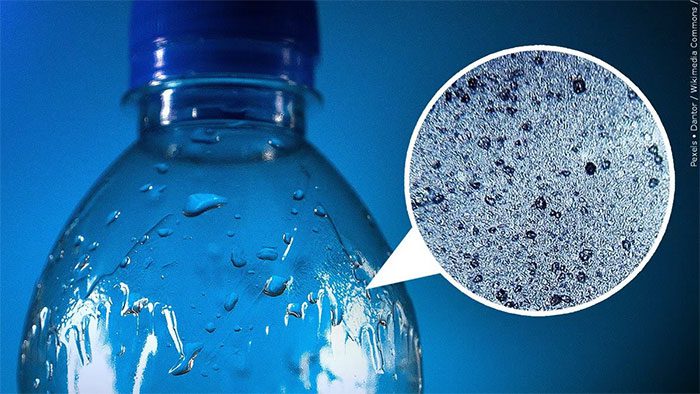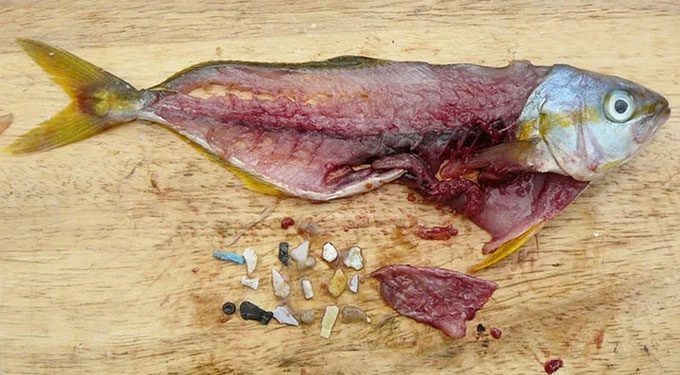Microplastics are one of the significant environmental issues today. They can be found everywhere on Earth.
In recent years, microplastics have been detected in various human body parts, including the lungs, placental tissues, breast milk, and human blood.
Microplastics scientist Heather Leslie from Vrije Universiteit Amsterdam in the Netherlands found microplastics in blood samples from 17 out of 22 healthy adult volunteers in the country.
The research has confirmed what many scientists have long suspected: these microplastic fragments can be absorbed into the bloodstream.

Microplastics have been found in bottled water. (Illustrative photo: WAFF).
In today’s world, plastics surround us in clothing, cosmetics, electronics, tires, packaging, and many other items.
Leslie stated: “There were about 3,000 plastic materials when I started researching microplastics over a decade ago. Now this number has grown to over 9,600 types, each with its own chemical composition and potential toxicity.”
Although durable, plastics still degrade due to weathering from water, wind, sunlight, or heat. In marine environments, landfills, or from friction caused by car tires, all of which release microplastic particles into the environment.
In addition to studying microplastic particles, researchers are also trying to address nanoplastics, which are smaller than 1 micrometer.
Toxicologist Dick Vethaak from the Institute for Risk Assessment Sciences at Utrecht University in the Netherlands explained: “Large plastic objects in the environment break down into microplastics and nanoparticles, a process that continuously increases the number of particles.”
Nearly two decades ago, marine biologists began to draw attention to the accumulation of microplastics in the oceans and their potential impact on the health of organisms and ecosystems.
However, it is only in recent years that scientists have started focusing on the issue of microplastics in human food and drinking water, as well as indoor air.
Plastic particles are also added to cosmetics like lipsticks, lip glosses, and eye makeup to enhance texture, and to personal care items such as facial scrubs, toothpaste, and body wash to improve cleansing properties.
When rinsed off, these microplastics enter the wastewater system and remain in the sludge of treatment plants, which is then used as fertilizer for agricultural land or even discharged into rivers and lakes.
The consequences of these microplastics entering our bodies remain unclear, but a community of researchers is developing to investigate these questions and suggests there is reason for concern.
Inhaled particles can irritate and damage the lungs, similar to damage caused by other particulate matter. And although the composition of plastic particles varies, some contain chemicals known to interfere with the body’s hormones.
How Do Microplastics Enter Our Bodies?
Research indicates two main pathways through which microplastics enter the human body: by ingestion and inhalation.
There is increasing evidence that our food and drinking water are contaminated with microplastics. A study in Italy in 2020 found microplastics in everyday fruits and vegetables.

Microplastics are also found in fish, entering our bodies indirectly through consumption. (Illustrative photo: Scientific American).
Wheat plants and lettuce have been observed absorbing microplastic particles in laboratory settings; absorption from soil containing these particles is likely how they enter our products in the first place.
A recent pilot study by the Plastic Soup Foundation found microplastics in all blood samples collected from pigs and cattle at Dutch farms, indicating that livestock can absorb some plastic particles from their food, water, or air.
Among beef and pork samples collected from farms and supermarkets, 75% showed the presence of microplastics. Many studies have noted that microplastics are also found in fish flesh and intestines, thus potentially being consumed when people eat seafood.
Microplastics are also present in our drinking water, including bottled products.
Results from studies attempting to quantify human ingestion levels suggest that individuals may consume tens of thousands of microplastic particles each year.
Furthermore, it remains unclear how these particles are absorbed, distributed, metabolized, and excreted by the human body and how long they can persist if not immediately excreted.
Infants may face particularly high exposure. A small study involving 6 infants and 10 adults showed that children have more microplastic particles in their stool than adults.
In particular, microplastics may cross the placenta to reach the fetus and infants can ingest these particles through breast milk. The use of plastic baby bottles and teething toys further increases children’s exposure to microplastics.
Microplastic particles are also floating in the air. A study conducted in Paris, France, revealed that the concentration of airborne microplastics indoors ranged from 3 to 15 particles per cubic meter of air, while outdoor concentrations were much lower.
Immunologist Nienke Vrisekoop from Utrecht University, Netherlands, stated: “If I leave a piece of fish on the table for an hour, it may collect more microplastics from the surrounding air than from the ocean.”
Potential Health Risks
Experimental studies on mice show that microplastics are not benign; exposure to them can disrupt the gut microbiome, leading to inflammation, reduced sperm quality, and testosterone levels in mice, while negatively affecting learning and memory.
Immunologist Barbro Melgert from the University of Groningen, Netherlands, has studied how human exposure to nylon fibers reduces both the number and size of airways formed in the tissues of this organ.
“Microplastics can be considered a form of air pollution. We know they pose a dangerous threat in our lungs.”
Vrisekoop is conducting another study related to how the human immune system reacts to microplastics (unpublished) which shows that immune cells do not recognize microplastic particles unless they are attached to blood proteins, viruses, bacteria, or other pollutants.
However, it is likely that such fragments will adhere to microplastic particles in the environment and within the body.
“If microplastics are not clean, immune cells will die quickly, causing a strong inflammatory response or could worsen existing inflammatory diseases of the lungs or gastrointestinal tract,” Vrisekoop warns.


















































